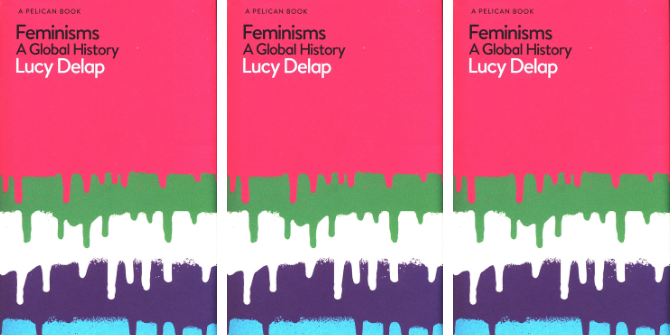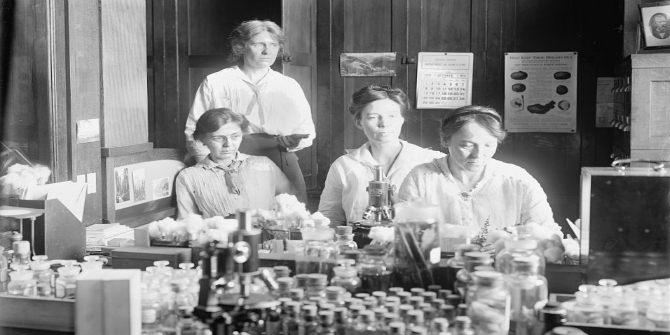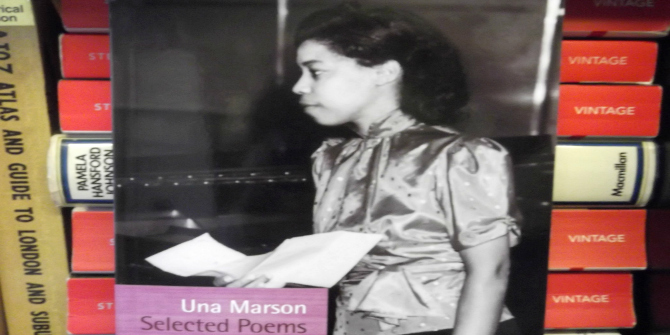In Anonymous is a Woman, Nina Ansary brings to life the stories of 50 trailblazing women whose lives and legacies have often been overlooked, featuring scientists, authors, medical pioneers and activists, amongst other figures. With stunning illustrations and a stated aim to inspire girls and women to push the boundaries of gendered expectations, this book shows the need to continue challenging exclusion and breaking down barriers to gender equality, writes Ava Berry.
Anonymous is a Woman. Nina Ansary. Revela Press. 2020.
 Nina Ansary’s book, Anonymous is a Woman, brings to life the stories of 50 women who have been questioning the gender order over the last 4000 years. Women who have fought the confines of expectations regarding womanhood and appropriate manifestations of femininity. Women who questioned why they could not be equal with men and participate in society — and then did it regardless. The book informs the reader that just 0.5 per cent of recorded history is about women, and the journey the book takes us on reminds us how hard global systems of patriarchy have fought to silence women and exclude them from public life.
Nina Ansary’s book, Anonymous is a Woman, brings to life the stories of 50 women who have been questioning the gender order over the last 4000 years. Women who have fought the confines of expectations regarding womanhood and appropriate manifestations of femininity. Women who questioned why they could not be equal with men and participate in society — and then did it regardless. The book informs the reader that just 0.5 per cent of recorded history is about women, and the journey the book takes us on reminds us how hard global systems of patriarchy have fought to silence women and exclude them from public life.
You can feel the injustice rise off the pages of the book as the magnitude of women’s invisibility is placed in front of you. The women featured in the book include scientists, authors, leaders in the field of medicine and peace activists. The context is set out on the first page through highlighting the writer Virginia Woolf’s (1882-1941, UK) questioning of the invisibility of women authors throughout history. Her words from 1929 have evolved since her original conclusion, ‘Indeed, I would venture to guess that Anon, who wrote so many poems without signing them was often a woman’, into the popularly referenced quote, ‘For most of history, anonymous was a woman’. 100 years later, equality has still not been achieved.
Each of the 50 women featured in the book were trailblazers. Eunice Newton-Foote (1819-88, US) was the first scientist to discover the principal cause of global warming. She authored a paper in 1856 titled ‘Circumstances Affecting the Heat of the Sun’s Rays’, which set out for the first time the hypothesis that the sun could affect certain gases which could, in turn, influence the Earth’s atmosphere. As a woman she was not allowed to present her paper, thus a male colleague took her place at a conference. As the impact of climate change becomes an ever-present threat globally, the book makes you question whether having more women at the table throughout history could have led to this issue being taken more seriously. Globally, women and girls are experiencing the most detrimental effects of the climate crisis as existing inequalities are magnified. The case is increasingly being made for prioritising women’s voices in combatting climate change as part of the Women, Peace and Security agenda.
Olivia Sabuco (1562-1622, Spain) was one of the first philosophers to theorise the mind-body connection, 50 years ahead of Descartes’s theory of mind-body dualism. She wrote a series of seven treaties exploring the relationship between the mind and body and made claim to the ‘symbiotic relationship between physical health and emotional wellbeing’. Despite being a leading philosophical thinker of the period, her father initially took credit for her seven treaties, and it was not until the twentieth century that they were revisited and realised as Sabuco’s original work.
The author of Anonymous is a Woman, Dr Nina Ansary, is a world-renowned Iranian American academic whose first book, Jewels of Allah, highlighted women’s experiences in Iran and won numerous prizes; she is currently Visiting Fellow at the LSE’s Centre for Women, Peace and Security. She references Jewels of Allah in the introduction to Anonymous is a Woman, and this book appears a natural progression in her work as an academic of women’s hidden histories. We like to believe that progress is linear; however, Ansary’s first book showcased the pushback on women’s rights that followed the Islamic Revolution in Iran in 1979. Gender-discriminating laws were introduced in the country and women’s rights movements in Iran are still fighting back. One can also turn to the US and see the attempts to reverse hard-won reproductive rights as an example in more recent years. Readers are reminded not to be complacent in our assumption of linear progression when it comes to gender equality.
Indeed, as a feminist in 2020, it is enlightening, and somewhat horrifying, how much a feminist text from the fifteenth century rings true in the present day. Italian French writer Christine de Pizan (1364-1430) is quoted in the book: ‘Therefore, it is not all men, especially not the most intelligent, who agree with the view that it is bad to educate women. However, it’s true that those who are not very clever come out with this opinion because they don’t want women to know more than they do.’
As the author writes in Chapter Two, ‘Women by Numbers’, it is not that there has been no cause to celebrate women’s advancement into public life; however, there are still a multitude of barriers from patriarchal societies and institutions. Clearly, women’s advancement has not been straightforward, and men are reluctant to give away the power they have maintained for thousands of years. The fight for equality continues. While women in the majority of countries have been granted access to education and the workplace, they continue to face gender-based discrimination, which is magnified by other aspects of identity such as race, sexuality and class. Discussions of race in the book do not shy away from feminism’s turbulent history with racism; the story of Black women being excluded from the main section of a protest in 1913 for the women’s right to vote in the US encapsulates much of what is still being played out today within some feminist movements, which can privilege white women’s voices and experiences.

One of the celebrated Black women in the book, Elizabeth Freeman (1742-1829, US), was the first to successfully file a lawsuit for her freedom from enslavement after 40 years. This set a precedent for future cases and led to the eventual abolition of slavery in Massachusetts. She went on to have a career as a popular midwife and nurse. Alimotu Pelewura (1865-1951, Nigeria) was an inspirational political activist, successfully fighting against unfair taxation of women traders and advocating for the right to vote. Her opposition to policies imposed by the colonial British government led to her being considered by them to be ‘a source of concern’. Bessie Coleman (1892-1926, US) was the first licensed Black American pilot; after being declined admission to schools due to her race and gender, she went on to learn French in order to attend a training school in France.
The book itself is visually stunning and the illustrations bring the women to life. Reading the book with children, you could imagine them skimming through the pages and asking questions about the different women pictured. In Chapter Two, the book references research on gender stereotyping and how it impacts children’s imaginings of what it means to be ‘a scientist’. Tellingly, boys drew men when asked what a scientist looks like. Yet, the majority of girls drew men too. The quotes in the book include those from girls stating that they only see men depicted as scientists. This shows that a scarcity of representation can create strong associations from a young age. Conversations about women scientists open up minds to the possibilities of science being an option for all genders. The author herself dedicates the book to her daughter and hopes it can encourage all girls to follow their interests regardless of gender.
Reading this book during the COVID-19 pandemic seems particularly timely. Feminists the world over have been shouting ‘Where are the women?’ as countries try to curb the spread of the disease. During a time when right-wing male populist leaders are dominating our political systems on a global scale, research has recently been published showing that women leaders have responded the most successfully to the virus, prioritising human life and keeping the numbers of deaths low. The book highlights some of the progress made for women in politics: for example, Spain has more women than men in the Prime Minister’s cabinet for the first time. However, just a quarter of the gap in politics has been closed globally, and some countries have closed just 3 per cent of the gap.
In Chapter Three of the book, ‘Yinyang and the Economics of Gender Balance’, the philosophical argument for gender equality is discussed, alongside research evidence that highlights how diverse teams produce better outcomes. The theory of yinyang has been around for thousands of years: the belief that harmony is created through a balance of female and male. The overarching powerful message of the book is that a diversity of voices and experiences is the central tenet of an inclusive society — and this means fighting for racial equality alongside gender parity.
The 50 women’s stories included in this book make you question what society would look like today had women not been written out of history. Gender stereotyping and discrimination are persistent beasts and children today are still faced with gendered role models that encourage them to follow traditional paths. The author hopes that capturing the ‘obscure lives’ of these 50 women from history can help girls and women in the present day feel inspired to push the boundaries of gendered expectations and follow their chosen path and passions. To question why girls and women are still being excluded and work to break down barriers to equality. Girls and women have waited long enough; it is their turn to write history.
Note: This review gives the views of the author, and not the position of the LSE Review of Books blog, or of the London School of Economics.
Please note that 100% of all profits from the sale of this book are being donated, with the primary recipients being The Center for Human Rights in Iran and the LSE Centre for Women, Peace and Security.
Image Credit: Cropped drawing of Elizabeth Freeman by artist Petra Dufkova.







